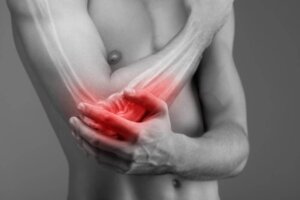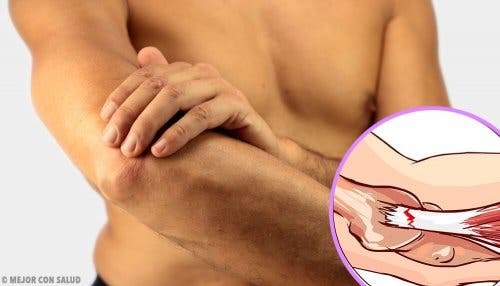Symptoms and Diagnosis of Tennis Elbow


Reviewed and approved by the biotechnologist Alejandro Duarte
Epicondylitis, commonly known as tennis elbow, is an inflammation of the epicondyle tendons. These are the ligaments that join the musculature of the forearm and hand with the lateral epicondyle of the humerus, on the outside of the elbow. The inflammation is caused by microtrauma due to muscle overload. Keep reading to learn more about the symptoms and diagnosis of tennis elbow.
It’s a very common condition in sports, hence its name, but also in the workplace. There are professions with a greater tendency to develop this injury due to the repetition of specific gestures.
This is the case in factories, office work with a computer, painters, or any activity that involves an overexertion of the musculature in charge of hand movements.
Symptoms of tennis elbow

The symptoms of epicondylitis appear progressively. In general, patients usually notice pain on the outside of the elbow and it can extend to the forearm.
You might feel discomfort when grasping objects, moving your fingers, turning your wrist, and when pressing the affected area at the points where the muscle joins with the ligament. In addition, it can cause a lack of strength in the forearm.
Read more: Relieve Your Tennis Elbow With These 5 Natural Remedies
Diagnosis of tennis elbow
It’s extremely important to make a correct diagnosis of the cause of pain in the elbow, in order to carry out the proper treatment, since there are different conditions that can have similar symptoms and lead to confusion.
Treatment-resistant epicondylitis, due to confusion in diagnosis, is usually due to entrapment of the posterior interosseous nerve in the lateral region of the elbow. The following are some conditions that report pain similar to that caused by tennis elbow:
- Neuropathy caused by entrapment of the radial nerve.
- Osteochondritis of the radio humeral joint.
- Pain in surrounding muscles, which although not directly to the area in which you feel pain, can cause discomfort.
- Changes in the head of the radius, located on the external face of the elbow.
For a correct diagnosis of epicondylitis, your doctor must follow the following protocol:
1. Patient’s medical history

- Visual examination: the doctor will perform a comprehensive examination of the physical appearance of the affected area. They’ll look for signs of inflammation, changes in the skin, deviation of the joint alignment, etc.
- They’ll locate the epicondyle and apply pressure to check if the patient feels pain in that specific area.
- Varus elbow stress test: force applied to the elbow that causes its distal face to move toward the midline of the body. The test will be positive if the patient reports discomfort.
- Pain when you extend the fingers with resistance.
- Examination of the mobility of the elbow and head of the radius, cervical spine, and the entire shoulder joint system.
- Gathering information about the patient’s daily activities that may influence the condition. Any medication the patient has recently used must also be taken into account.
Read more: The Causes of Biceps Tendinitis
Pronation and supination
It’s important to understand the concept of pronation and supination of the forearm to understand the following tests.
Supination is the lateral rotation of the forearm and hand. The palm of the hand is directed upward with the thumb outward. Pronation is the medial rotation of the forearm and hand. In this case, the palm of the hand faces downward with the thumb inward.
- Mill’s maneuver. The patient will remain seated with the arm slightly rotated, with dorsal extension of the hand and flexion of the elbow.
- The physical therapist will place one hand on the elbow and the other on the side of the forearm. The patient will be asked to try to supinate the forearm (rotate the forearm and hand up) against resistance from the physician’s hand. If they feel pain when performing this action, it’s likely that it’s a case of tennis elbow.
- Chair test: The patient will be asked to lift a chair in two different ways. When holding it with the pronated hand and elbow extended, they will feel pain. However, there won’t be discomfort when grasping it with the supinated hand.
2. Other tests
If, with the previous examination, they can’t make a diagnosis of tennis elbow, other complementary tests will be carried out:
- Analytical, to rule out the existence of uric acid crystals in the joint caused by hyperuricemia
- Electromyography, to rule out nerve compression syndromes
- Radiology and complementary tests
All cited sources were thoroughly reviewed by our team to ensure their quality, reliability, currency, and validity. The bibliography of this article was considered reliable and of academic or scientific accuracy.
- Kaminsky, S. B., & Baker, C. L. (2003). Lateral epicondylitis of the elbow. Sports Medicine and Arthroscopy Review. https://doi.org/10.1097/00132585-200311010-00009
- Salmon, J., & Davidson, S. (1968). TREATMENT OF LATERAL EPICONDYLITIS. Australian Journal of Physiotherapy. https://doi.org/10.1016/S0004-9514(14)61051-5
- Walz, D. M., Newman, J. S., Konin, G. P., & Ross, G. (2010). Epicondylitis: Pathogenesis, Imaging, and Treatment. RadioGraphics. https://doi.org/10.1148/rg.301095078
This text is provided for informational purposes only and does not replace consultation with a professional. If in doubt, consult your specialist.








